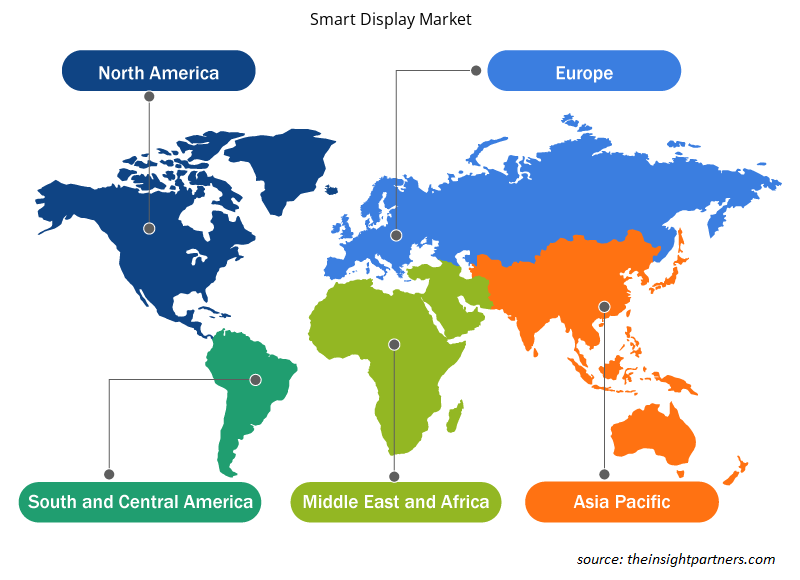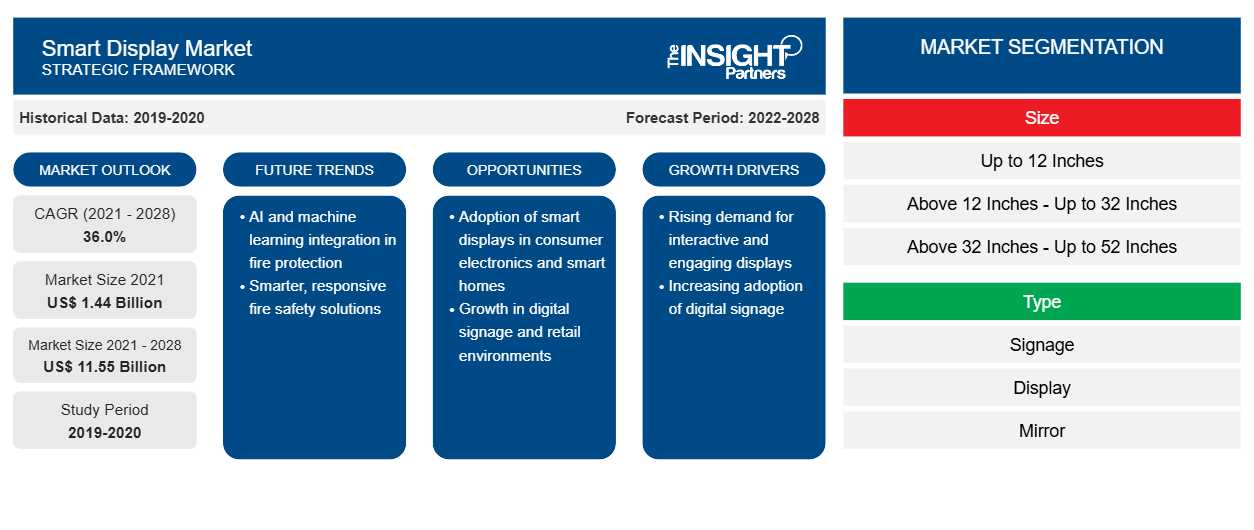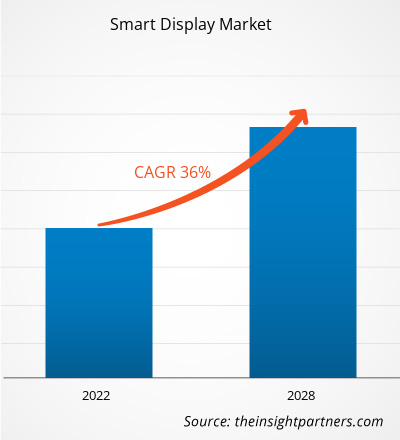2021 年智能显示器市场价值为 14.4374 亿美元,预计到 2028 年将达到 115.4723 亿美元;预计 2022 年至 2028 年的复合年增长率为 36.0%。
智能显示屏是一种数字显示屏,可使用语音遥控设备或物联网 (IoT) 连接设备进行操作。例如,智能镜子是一种创新设备,可记录汽车和零售行业的用户个人信息和购物者的体验。此外,作为一种尖端技术解决方案,智能显示屏包括交互和复杂的控制功能。
汽车行业对智能镜子的需求很高 、智能镜子提供的新颖和创新功能、互联网用户数量的增加以及根据消费者偏好而不断增长的智能设备的采用、对支持人工智能和物联网的智能家电的需求激增、情境感知标牌的趋势日益增长以及零售业越来越多地采用智能标牌是推动智能显示器市场增长的关键驱动因素。
零售业的蓬勃发展得益于消费者购买力的不断增强。此外,全球范围内迅速扩张的购物中心和零售空间推动了对智能标牌解决方案的需求,以吸引路人并鼓励他们进入商店。因此,智能商店有兴趣使用程序化广告来提高品牌知名度。智能标牌还可以用作支付流程的一部分。客户可以使用移动设备付款,而不必排队结账。沃尔玛、阿里巴巴、亚马逊和家乐福等多家零售商已在全球开设了智能商店。他们在智能商店中使用各种智能零售解决方案和技术,例如智能标牌。全球零售商已经实施了扩张和合作战略,以开设更智能、无收银员的商店。所有这些因素都在推动智能显示器市场规模的增长。
定制此报告以满足您的需求
您可以免费定制任何报告,包括本报告的部分内容、国家级分析、Excel 数据包,以及为初创企业和大学提供优惠和折扣
- 获取此报告的关键市场趋势。这个免费样品将包括数据分析,从市场趋势到估计和预测。
智能显示市场洞察
热门品牌入驻
一旦客户习惯了某个品牌的产品,他们就会购买同一品牌的其他产品。一些知名品牌,如谷歌、亚马逊公司、博世、松下、明基电通、LG 电子、联想集团、三星公司和索尼公司,为汽车、医疗保健、住宅和零售行业提供各种智能显示解决方案。这些品牌毫不费力地吸引了忠实客户,是智能显示器市场增长的主要驱动因素。品牌有时会在产品发布前推广其产品,以在客户中引起轰动。例如,2022 年 3 月,小米的智能显示器 10 在多个网站上列出,该产品于 2022 年 4 月推出。2022 年 1 月,谷歌在印度以 103.24 美元的价格推出了第二代 Google Nest Hub 智能显示器。2021 年 6 月,亚马逊在印度市场推出了 2 款新的智能显示产品;Echo show 10 和 5。因此,品牌的日益普及正在推动智能显示器市场的增长。
基于规模的市场洞察
根据尺寸,智能显示器市场细分为 12 英寸以下、12 英寸以上至 32 英寸、32 英寸以上至 52 英寸和 52 英寸以上。屏幕尺寸因制造商而异。虽然一些制造商即使在较小的屏幕尺寸下也能提供更高的功能,但其他制造商则倾向于根据屏幕尺寸改变功能。该市场主要受到全球各个垂直行业对中型智能标牌显示器不断增长的需求的推动。
基于解决方案的市场洞察
根据分辨率,智能显示器市场分为全高清 (FHD)、超高清 (UHD) 和其他。具有高清分辨率的智能显示器主要用于住宅应用。然而,大多数其他应用,如广告标牌或智能信息亭,越来越多地使用具有 UHD 和 FHD 分辨率的显示器。市场主要受到对具有更高分辨率的智能标牌显示器日益增长的需求的推动,以便用户可以享受身临其境的体验。
智能显示器市场参与者采用合并、收购和市场计划等策略来保持其在市场中的地位。以下列出了主要市场参与者的一些发展:
- 据 Android数字标牌行业领导者和先驱 NoviSign 称, NoviSign Android数字标牌应用目前适用于所有基于 Android 的 Sony BRAVIA Professional 显示器。索尼的专业 BRAVIA 系列支持 4K 和 HDR,拥有片上系统平台,尺寸从 32 英寸到 100 英寸不等。
- 交互式显示技术领导者 BenQ 加入了 Google 的教育综合解决方案计划。BenQ 致力于提供教育解决方案,帮助学校构建更具弹性的主动学习环境,适合面对面和远程学习。通过加入该计划,BenQ 将继续履行这一承诺。
智能显示市场区域洞察
Insight Partners 的分析师已详尽解释了预测期内影响智能显示器市场的区域趋势和因素。本节还讨论了北美、欧洲、亚太地区、中东和非洲以及南美和中美洲的智能显示器市场细分和地理位置。

- 获取智能显示市场的区域特定数据
智能显示市场报告范围
| 报告属性 | 细节 |
|---|---|
| 2021 年市场规模 | 14.4亿美元 |
| 2028 年市场规模 | 115.5亿美元 |
| 全球复合年增长率(2021 - 2028) | 36.0% |
| 史料 | 2019-2020 |
| 预测期 | 2022-2028 |
| 涵盖的领域 | 按尺寸
|
| 覆盖地区和国家 | 北美
|
| 市场领导者和主要公司简介 |
|
市场参与者密度:了解其对商业动态的影响
智能显示器市场正在快速增长,这得益于终端用户需求的不断增长,而这些需求又源于消费者偏好的不断变化、技术进步以及对产品优势的认识不断提高等因素。随着需求的增加,企业正在扩大其产品范围,进行创新以满足消费者的需求,并利用新兴趋势,从而进一步推动市场增长。
市场参与者密度是指在特定市场或行业内运营的企业或公司的分布情况。它表明在给定市场空间中,相对于其规模或总市场价值,有多少竞争对手(市场参与者)存在。
在智能显示器市场运营的主要公司有:
- Alphabet 公司
- 亚马逊公司 (Amazon.com, Inc.)
- LG 电子
- 联想集团有限公司
- 麦格纳国际公司
免责声明:上面列出的公司没有按照任何特定顺序排列。

- 了解智能显示器市场顶级关键参与者概况
全球智能显示器市场根据尺寸、类型、分辨率和行业进行细分。根据尺寸,市场细分为 12 英寸以下、12 英寸以上 - 32 英寸以下、32 英寸以上 - 52 英寸以下和 52 英寸以上。就类型而言,市场细分为标牌、显示器和镜子。根据分辨率,市场细分为全高清、超高清和其他。此外,根据行业,智能显示器市场细分为消费和家电、汽车、零售、医疗保健和其他。
Alphabet Inc.;Amazon.com, Inc.;LG Electronics;联想集团有限公司;Magna International Inc;松下公司;索尼公司;明基电通公司;NEXCOM International Co., Ltd.;以及三星电子有限公司是本次研究考虑的主要智能显示器市场参与者。此外,本研究报告还研究和分析了其他几家重要的市场参与者,以全面了解全球智能显示器市场及其生态系统。
- 历史分析(2 年)、基准年、预测(7 年)及复合年增长率
- PEST 和 SWOT 分析
- 市场规模价值/数量 - 全球、区域、国家
- 行业和竞争格局
- Excel 数据集


- Trade Promotion Management Software Market
- Pressure Vessel Composite Materials Market
- Authentication and Brand Protection Market
- Medical Second Opinion Market
- Third Party Logistics Market
- Aircraft MRO Market
- 3D Audio Market
- Europe Industrial Chillers Market
- Aerospace Forging Market
- Bathroom Vanities Market

Report Coverage
Revenue forecast, Company Analysis, Industry landscape, Growth factors, and Trends

Segment Covered
This text is related
to segments covered.

Regional Scope
North America, Europe, Asia Pacific, Middle East & Africa, South & Central America

Country Scope
This text is related
to country scope.
常见问题
The adoption of smart signage enables a variety of content to be displayed and scheduled multiple times in a day or week. The context-aware smart signage provides active and real-time information. For instance, it can provide information related to weather; during the rainy season, it can show advertisements for umbrellas, or in summer, it can display advertisements for sunglasses.
The countries that registered a high growth rate during the forecast period are United States, Germany, UK, China, India, and South Korea
Based on type, the smart display market is segmented into display, mirror, and signage. The display segment mostly consists of smart display devices, such as Amazon’s Echo Show and Google’s Nest Max, and automotive smart displays. The growing penetration of IoT and the increasing adoption of smart home products drive market growth.
The top five key players operating in the global smart display market include Amazon, Baidu, Google, Alibaba, and Apple in 2021.
The global market size for smart display market in 2021 is estimated to be $ 1443.74 million.
The driving factors that influence the global smart display market are technological advancements and presence of popular brands.
Trends and growth analysis reports related to Electronics and Semiconductor : READ MORE..
The List of Companies - Smart Display Market
- Alphabet Inc.
- Amazon.com, Inc.
- LG Electronics
- LENOVO GROUP LIMITED
- Magna International Inc
- Panasonic Corporation
- Sony Corporation
- BenQ Corporation
- NEXCOM International Co., Ltd.
- Samsung Electronics Co., Ltd.
The Insight Partners performs research in 4 major stages: Data Collection & Secondary Research, Primary Research, Data Analysis and Data Triangulation & Final Review.
- Data Collection and Secondary Research:
As a market research and consulting firm operating from a decade, we have published and advised several client across the globe. First step for any study will start with an assessment of currently available data and insights from existing reports. Further, historical and current market information is collected from Investor Presentations, Annual Reports, SEC Filings, etc., and other information related to company’s performance and market positioning are gathered from Paid Databases (Factiva, Hoovers, and Reuters) and various other publications available in public domain.
Several associations trade associates, technical forums, institutes, societies and organization are accessed to gain technical as well as market related insights through their publications such as research papers, blogs and press releases related to the studies are referred to get cues about the market. Further, white papers, journals, magazines, and other news articles published in last 3 years are scrutinized and analyzed to understand the current market trends.
- Primary Research:
The primarily interview analysis comprise of data obtained from industry participants interview and answers to survey questions gathered by in-house primary team.
For primary research, interviews are conducted with industry experts/CEOs/Marketing Managers/VPs/Subject Matter Experts from both demand and supply side to get a 360-degree view of the market. The primary team conducts several interviews based on the complexity of the markets to understand the various market trends and dynamics which makes research more credible and precise.
A typical research interview fulfils the following functions:
- Provides first-hand information on the market size, market trends, growth trends, competitive landscape, and outlook
- Validates and strengthens in-house secondary research findings
- Develops the analysis team’s expertise and market understanding
Primary research involves email interactions and telephone interviews for each market, category, segment, and sub-segment across geographies. The participants who typically take part in such a process include, but are not limited to:
- Industry participants: VPs, business development managers, market intelligence managers and national sales managers
- Outside experts: Valuation experts, research analysts and key opinion leaders specializing in the electronics and semiconductor industry.
Below is the breakup of our primary respondents by company, designation, and region:

Once we receive the confirmation from primary research sources or primary respondents, we finalize the base year market estimation and forecast the data as per the macroeconomic and microeconomic factors assessed during data collection.
- Data Analysis:
Once data is validated through both secondary as well as primary respondents, we finalize the market estimations by hypothesis formulation and factor analysis at regional and country level.
- Macro-Economic Factor Analysis:
We analyse macroeconomic indicators such the gross domestic product (GDP), increase in the demand for goods and services across industries, technological advancement, regional economic growth, governmental policies, the influence of COVID-19, PEST analysis, and other aspects. This analysis aids in setting benchmarks for various nations/regions and approximating market splits. Additionally, the general trend of the aforementioned components aid in determining the market's development possibilities.
- Country Level Data:
Various factors that are especially aligned to the country are taken into account to determine the market size for a certain area and country, including the presence of vendors, such as headquarters and offices, the country's GDP, demand patterns, and industry growth. To comprehend the market dynamics for the nation, a number of growth variables, inhibitors, application areas, and current market trends are researched. The aforementioned elements aid in determining the country's overall market's growth potential.
- Company Profile:
The “Table of Contents” is formulated by listing and analyzing more than 25 - 30 companies operating in the market ecosystem across geographies. However, we profile only 10 companies as a standard practice in our syndicate reports. These 10 companies comprise leading, emerging, and regional players. Nonetheless, our analysis is not restricted to the 10 listed companies, we also analyze other companies present in the market to develop a holistic view and understand the prevailing trends. The “Company Profiles” section in the report covers key facts, business description, products & services, financial information, SWOT analysis, and key developments. The financial information presented is extracted from the annual reports and official documents of the publicly listed companies. Upon collecting the information for the sections of respective companies, we verify them via various primary sources and then compile the data in respective company profiles. The company level information helps us in deriving the base number as well as in forecasting the market size.
- Developing Base Number:
Aggregation of sales statistics (2020-2022) and macro-economic factor, and other secondary and primary research insights are utilized to arrive at base number and related market shares for 2022. The data gaps are identified in this step and relevant market data is analyzed, collected from paid primary interviews or databases. On finalizing the base year market size, forecasts are developed on the basis of macro-economic, industry and market growth factors and company level analysis.
- Data Triangulation and Final Review:
The market findings and base year market size calculations are validated from supply as well as demand side. Demand side validations are based on macro-economic factor analysis and benchmarks for respective regions and countries. In case of supply side validations, revenues of major companies are estimated (in case not available) based on industry benchmark, approximate number of employees, product portfolio, and primary interviews revenues are gathered. Further revenue from target product/service segment is assessed to avoid overshooting of market statistics. In case of heavy deviations between supply and demand side values, all thes steps are repeated to achieve synchronization.
We follow an iterative model, wherein we share our research findings with Subject Matter Experts (SME’s) and Key Opinion Leaders (KOLs) until consensus view of the market is not formulated – this model negates any drastic deviation in the opinions of experts. Only validated and universally acceptable research findings are quoted in our reports.
We have important check points that we use to validate our research findings – which we call – data triangulation, where we validate the information, we generate from secondary sources with primary interviews and then we re-validate with our internal data bases and Subject matter experts. This comprehensive model enables us to deliver high quality, reliable data in shortest possible time.


 获取此报告的免费样本
获取此报告的免费样本